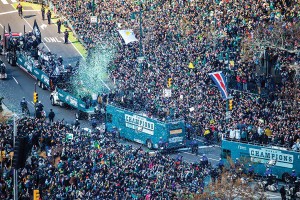Beautiful Music
Curtis students learn to sing increasingly complicated music at sight, to listen to music they have never heard before and write it down as if they’re simply taking dictation. These days, they’re even taught how to converse at a cocktail reception or dinner party. But what’s happening in this room between Ida Kavafian and Becky Anderson is the essential element of this eccentric place, and it is in many ways ineffable.
It’s something like those guitar lessons you took when for a few months you wanted to be the next Bruce Springsteen. But not really — not nearly. In some ways, it’s like working on your short game with the club golf pro, or sweating through an intense session in the weight room with your personal trainer. Only that’s like comparing apples to gemstones. Yes, some are green and some are red, but …
“What I really wanted when I came to Curtis,” trumpeter Elin Frazier told me, “was to have a place that was cut off from the mundane world. To study with a master teacher and practice. It was very much the idea of one master teacher passing how to do it through the next generation.”
While the weight of tradition may hinder the classical music world’s nimbleness in responding to change, the student-teacher tradition is like the eternal golden braid, linking great musicians across oceans and generations. When China-born Haochen Zhang, the Van Cliburn contest winner, takes a lesson with Gary Graffman, he’s getting not just Graffman, but also Graffman’s childhood teacher, the redoubtable Madame Isabelle Vengerova, as well as his later teachers, Rudolf Serkin and Vladimir Horowitz. One of Curtis’s first piano teachers, Josef Hofmann, had studied with Anton Rubinstein, who had studied with the legendary soloist and pedagogue Carl Czerny. Czerny had studied with Beethoven.
Ida Kavafian trained at Juilliard under Oscar Shumsky, a Philadelphia violinist who first performed with the Philadelphia Orchestra before he was 10, and who attended Curtis. “I can tell you that Oscar Shumsky permeates every single thing I do in music,” she says, “not just specifically, though there is some of that, but conceptually and philosophically. He is by far the single biggest musical influence on my life.”
For her next lesson with Kavafian, Becky brings back the Chausson Poème and a pianist to accompany her. That goes well, and in the lesson after that, she plays alone again. At the end of the lesson, Kavafian tells her, “It’s just too pretty.”
“She’s completely right,” Becky says. “It’s an incredibly beautiful piece, but there are dark parts of it. I need to have a better sound — not prettier, but the best sound, and sometimes that could actually sound extremely unhealthy. Sometimes I need to scratch a little bit. I’ve been practicing trying to get it very smooth. But it’s not just pretty; it’s trying to express something much deeper than that. Ida keeps pushing to make me keep thinking — not just make it beautiful.”


